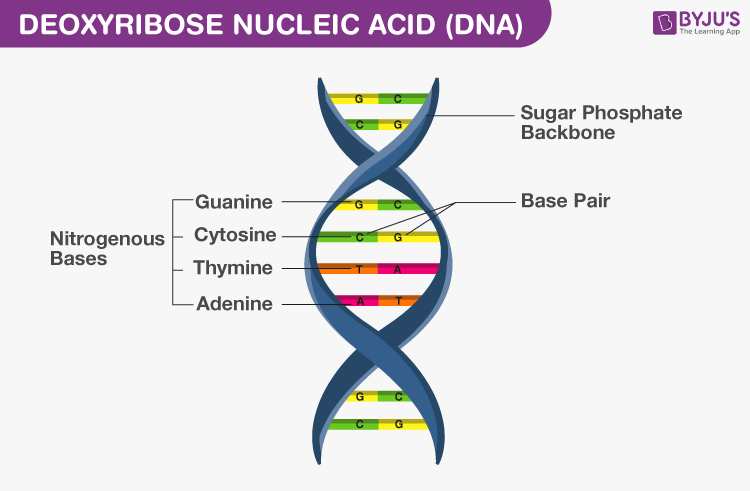Genetics mainly deals with the study of genes, heredity, and genetic variation. Genes exist on chromosomes and chromosomes are comprised of DNA and proteins. DNA is a molecule that carries genetic information in all living organisms and viruses where it is used in reproduction, functioning, growth, and development. It is a long polymer of deoxyribonucleotides.
Refer to the molecular basis of inheritance notes provided here for conceptual understanding of the topic.
DNA
DNA is a double-helical structure that carries all the genetic information. Its length is determined by the number of nucleotide pairs present in it. It is an acidic substance in the nucleus identified by Friedrich Meischer. Its double helical structure was given by Watson and Crick.
Also Read: DNA Structure
Structure
DNA is made up of 6 molecular structures that comprise of one phosphate molecule and five carbon sugar termed deoxyribose. A nucleotide is a basic building block of DNA. A nucleotide is comprised of one of the 4 bases, one sugar molecule, and one phosphate molecule. A sugar-phosphate chain act as a backbone and bases are on the inside. Nucleotide subunits are linked together to form a DNA strand thus providing polar stability.

The three-dimensional structure of DNA arises from chemical and structural features of 2 polynucleotide chain. A purine base pairs up with pyrimidine base. For instance guanine pairs with cytosine. So the two strands that are held together by a hydrogen bond are complementary to each other and they run in the antiparallel direction.
Central Dogma
The central dogma was proposed by Crick. The central dogma states that the DNA is converted into RNA and the RNA is converted into proteins.
In retroviruses, the flow of information is opposite, i.e., RNA to DNA to mRNA to Protein.
DNA Packaging
The negatively charged DNA is packaged by surrounding the positively charged histone octamer. A structure called nucleosome is formed. The DNA is packed in chromatin of eukaryotes.
DNA Replication
DNA is self-replicative. It occurs in the S-phase of the life cycle. It takes only a few minutes in prokaryotes but hours in eukaryotes. DNA undergoes semi-conservative replication, i.e., two strands of DNA are formed. One strand is the same as one of the strands while the other is complementary to the parent strand. The replication occurs in 5′-3′ direction.
Also Read: DNA Replication
RNA
Ribonucleic acid or RNA is a vital molecule with a long chain of nucleotides. It is the first genetic material. A nucleotide chain comprises a phosphate, a ribose sugar, and nitrogenous base. RNA acts as a catalyst and as genetic material. There are two types of RNA, that is genetic and non-genetic.
Genetic Code
The genetic code can be defined as a set of rules wherein the information encoded in genetic materials are translated into proteins by living cells. The code defines how codons specify which amino acids will be added next during protein synthesis.
The frequency of codon is termed as codon usage bias. It varies from species to species in terms of functional implications for the control of translation.
The genetic code can also be defined as a relationship between the sequence of amino acids in a nucleotide chain of mRNA or DNA and amino acid in a polypeptide chain.
Nearly twenty types of amino acids participate in protein synthesis. Sixty-one codons out of sixty-four codons code only for amino acids. The characteristics of the genetic code are stated below:
- Degeneracy of genetic code.
- Non-overlapping.
- Universality.
- Triplet in nature.
- Comma-less.
- Non-ambiguous.
Human Genome Project
The human genome project was launched to sequence the entire human genome of 2.75 billion base pairs. The main goals of the human genome project are:
- To provide a complete sequence of 3 billion base pairs that make up the human genome.
- To sequence the genome of other organisms that are used in medical research. For eg, mouse, flies, etc.
- To develop new tools to obtain and analyse the data and to make this data widely available.
- It holds prospects for healthier living, a database of knowledge about designer drugs, genetically modified diets, and genetic identity.
Also Read: Structure of RNA
For more detailed information about the molecular basis of inheritance class 12, keep visiting BYJU’S website or download BYJU’S app for further reference.
Frequently Asked Questions
What is the molecular basis of inheritance?
Molecular basis of inheritance involves the study of genes, genetic variations and heredity. It explains how an offspring looks similar to the parents. DNA, RNA and genetic code form the basis of the molecular basis of inheritance. They transmit the hereditary genes from the parents to the offspring.
How does DNA play a role in the molecular basis of inheritance?
DNA carries all the genetic information of an individual. When it replicates each strand gives rise to a daughter strand and passes the genetic information to it. This way it forms the basis of inheritance.
What is the central dogma?
Central dogma states that the DNA is converted into RNA which is further converted into proteins. In virus, it is reversed. The RNA is first converted to DNA. The DNA is then converted to mRNA which is again converted into proteins.
Register at BYJU’S for more molecular basis of inheritance notes. Explore the notes for reference.

How RNA carry genetic information
mRNA is transcribed using the DNA template and carries the information present in DNA for protein synthesis. Each codon, which is a trinucleotide sequence specifies a particular amino acid and the sequence of codons directs the sequence of amino acids in the polypeptide chain.